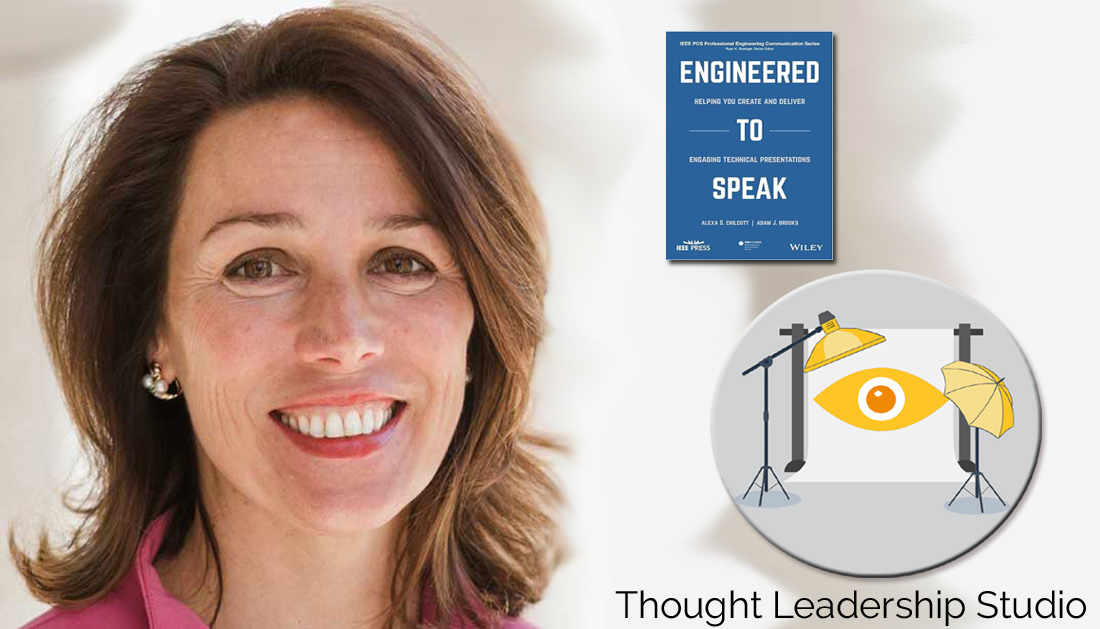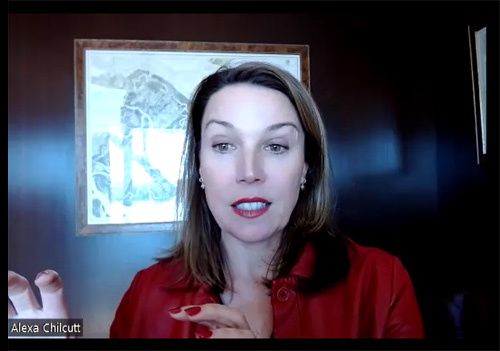Thought Leadership Studio Podcast Episodes:
Elevating Leadership Communication with Dr. Alexa Chilcutt
Episode 68 - Crafting Executive Presence and Influence: Insights from Dr. Alexa Chilcutt on Mastering the Dynamics of Leadership Communication

#coaching, #consulting, #interviews, #leadership, #thoughtleadership
Or Click here to listen or subscribe on appWhat this episode will do for you
:
- Discover Executive Presence: Learn from Dr. Alexa Chilcutt about the core aspects of executive presence and why it's crucial for leadership success.
- Effective Leadership Communication: Uncover strategies to enhance your communication skills and how they impact leadership and team dynamics.
- Navigating Virtual Engagement: Gain insights into overcoming the challenges of connecting and leading in virtual environments.
- Personal Branding and Perception: Explore how to align your personal branding with your leadership goals through strategic communication.
- Actionable Tips for Public Speaking: Receive practical advice on improving public speaking skills, whether in person or digitally.
- Overcoming Speaking Anxiety: Dr. Chilcutt shares methods to manage and overcome anxiety related to public speaking and presentations.
- Resources for Continuous Learning: Learn about essential resources for further developing your executive presence and leadership communication skills.
Alexa Chilcutt, PhD
In this episode of Thought Leadership Studio, I'm joined by Dr. Alexa Chilcutt, a distinguished expert renowned for her work in leadership and team communication, professional public speaking, and executive presence.
With a rich background that combines academic insight and real-world experience, Dr. Chilcutt delves into the pivotal role of communication in professional settings. She underscores the critical balance between technical acumen and the art of effective communication in leadership.
Throughout our conversation, Dr. Chilcutt unveils practical strategies for enhancing executive presence, navigating the nuances of virtual communication, and mastering public speaking. Whether you're looking to elevate your leadership skills or seeking ways to engage more effectively with your team, this episode is packed with valuable insights and actionable advice.
Some of Alexa's coordinates and recommended resources:
Curated Transcript of Interview with Dr. Alexa Chilcutt
The following partial transcript is lightly edited for clarity - the full interview is on audio. Click here to listen.
Chris McNeil: I'm Chris McNeil, with Thought Leadership Studio, and I'm sitting across Zoom with Dr. Alexa Chilcutt, who is an expert in leadership and team communication, professional public speaking skills, and in particular executive presence as we're just discussing. And we'll learn all about the things you do and what you can teach our listeners throughout this. Welcome Alexa.
 Alexa Chilcutt, Ph.D.: I'm glad to be here, Chris. I think it'll be a fun conversation. It's one of my most favorite topics.
Alexa Chilcutt, Ph.D.: I'm glad to be here, Chris. I think it'll be a fun conversation. It's one of my most favorite topics.
Chris McNeil: Awesome.
Alexa Chilcutt, Ph.D.: It'll be good.
Chris McNeil: Well, to give our listener a bit of a frame with which to know where you're coming from, do you have a story or a life experience that set you on a path of doing this kind of executive coaching in general of when life shifted and that was the right thing to do?
Alexa Chilcutt, Ph.D.: Yeah.
Chris McNeil: Or how'd it come to you?
Alexa Chilcutt, Ph.D.: I'll tell you what, I have always been a very practical applied person. My background, my corporate, if you will, background was actually working in advertising and public relations. And so I worked as a development director. If anyone knows what development directors do, they do everything. So it's from marketing, public relations, raising money, all of that.
And so I worked as a development director for a nonprofit for many years in my younger life. And so I think that's why I also now just love the topic of impression management and executive presence, because that is what you're doing is basically, but I returned to school, got a PhD in Communication information sciences, was a professor at the University of Alabama for 11 years, have now worked for Johns Hopkins, Carey Business School for the past five. And I teach executive education. I developed and deliver training courses on a variety of communication topics.
And I think the reason that I'm in this career now, and I do a lot of executive coaching on the side as well as different corporate training programs, is just because I love working with professionals and they are those individuals who really are hungry for information about how to elevate where they are and taking that time out to go, okay, where am I currently and where do I want to be and what are the skills that are going to get me there? So I am very energized by working with professionals.
Communication as the Defining Skill
Chris McNeil: I'll bet. So what are some of these skills that will help get an executive from A to B?
Alexa Chilcutt, Ph.D.: Honestly, communication skills are some of the biggest skill sets. There are no perfect speakers. There are no perfect communicators. We're all constantly learning, constantly adjusting our communication style to our audience. But learning how to communicate in a clear, concise, confident manner to a variety of audiences and pivot how you communicate based on that audience their need, why they need that information is that is the number one skill for any professional.
 Let's take the example of you can have a brilliant technical professional. Maybe they're a brilliant engineer or a scientist or in finance, who knows. But that technical expertise does not equate to leadership success. It just doesn't. How they communicate what they do and why it matters is the defining skill.
Let's take the example of you can have a brilliant technical professional. Maybe they're a brilliant engineer or a scientist or in finance, who knows. But that technical expertise does not equate to leadership success. It just doesn't. How they communicate what they do and why it matters is the defining skill.
Chris McNeil: Agree a hundred percent. And I like how you're bringing out that feedback loop with the audience because it's all about adjusting your communication to the audience. And we talked before we started recording about executive presence, which to me, and I don't consider myself an expert on executive presence learning, I'm a learner, but to me it's about being able to maintain a state of confidence and really being congruent with your values, which comes across what else makes for a good executive presence?
What am I missing? What do I need to fill out my model with?
Alexa Chilcutt, Ph.D.: Okay. So when I teach executive presence, I think a lot of people immediately, and I think in the past it was taught this way. It was really around charisma and gravitas and communication skills, appearance and that kind of thing.
As we have kind of shifted and grown and developed just as people working in professional spaces. And we realized that it's not just those first impressions, it is our evaluations of someone, their values in action, their interpersonal integrity, their outcome delivery. It's those types of qualities that really enhance someone's executive presence. So they can make a fabulous first impression, but then they need to maintain those impressions over time to really be seen as a credible person with leadership skills that people want to trust and align themselves with.
The Art of Executive Presence: Reflection, Perception, and the Journey to Authentic Leadership
Chris McNeil: Makes sense. And especially with the transparency that today's media gives us - experts in general, leaders in general - people see through the transparent walls in this only over time so that only congruence, so to speak, is going to really come across and win people over.
So when you're working with a client who comes to you and says, who wants you to look at improving their executive presence, what are the points where they're at versus where you'd like them to get to? Do you have kind of a mental checklist, so to speak, you work from? Or is it more holistic or how does that work for you?
Alexa Chilcutt, Ph.D.: Yeah, I mean, I think part of it is holistic and it is really finding out, I think a great, okay, place to start is a question. If I were to pull the people that you work with horizontally up to management, et cetera, down direct reports, if I were to pull all of those people, what are the adjectives that they would use to describe you? And then people have to have a real self-reflective moment. Are those the adjectives that they feel are most advantageous to where they want to be?
 Because I don't know if you are familiar with Carla Harris. Carla Harris wrote the books Strategize to Win, Expect to Win and Lead to Win. And she was the senior vice president of Morgan Stanley for many, many years. She was a woman on Wall Street. She's a black woman who is graduated from Harvard twice. I mean, just brilliant.
Because I don't know if you are familiar with Carla Harris. Carla Harris wrote the books Strategize to Win, Expect to Win and Lead to Win. And she was the senior vice president of Morgan Stanley for many, many years. She was a woman on Wall Street. She's a black woman who is graduated from Harvard twice. I mean, just brilliant.
But she is a very much a thought leader in this space. And she does this activity where she says, okay, now think of three adjectives that you would like people to use about you when you are not in the room, because it's when you're not in the room that all the decisions about your advancement promotion are going to be made. And so getting people to think about, okay, how am I currently being perceived, whether I'm intending to be perceived that way or not, and then what are the perceptions that will really be advantageous for me to elevate, to kind of elevate that perception? And that allows us to have kind of a starting place.
A lot of people come and they want, honestly, a lot of people send me clients who have been identified as high potential in an organization, and that manager or supervisor wants me to coach them to work on their executive presence. And some of it really just begins with those kind of impressions of them. How are they showing up in a space? How are they showing up online? How are they communicating when they're running a meeting or giving a project update?
So it can be a lot of things, but also showing and sharing with people all of the characteristics. And there are 10 designed by research that have kind of come out 10 characteristics of executive presence, and five of them are short term impressions, and five of them are those more substantive values over time impressions.
Chris McNeil: Interesting. Well, what do you think would be the most important one out of the short term ones to focus on if you had to choose one?
Alexa Chilcutt, Ph.D.: If I had to choose one? Well, I'm going to reframe that if I can. Okay. The easiest ones are working on people's nonverbal communication.
How are they coming into a space? How are they showing up online? You can make little tweaks to that that have really big impact. How are they walking in a room? How are they taking up space in a meeting? All of those small things. Appearance. I mean, appearance is not prescriptive. You need to wear this, but are you looking the part, right? Are you looking like you're together? Are you engaged?
So a lot of it is nonverbal. That's a short-term kind of fix. The next thing is communication skills. And I think the communication skills part is something that coaching on presentation skills, leading meetings, communicating what you're doing and why it's important. Those are skills that you can help somebody build.
Chris McNeil: I'll bet. And so those kind of communication skills, what are some models that you use? Can you maybe bring it a little more to ground for our listeners with a tangible example or two?
Alexa Chilcutt, Ph.D.: Okay, so thinking about just presentation skills. Let's say that you have to give a project update regularly in meetings. How are you even crafting that project update? There are some simple rules of public speaking that can be followed. Are you opening with why it matters to the audience immediately instead of, Hey, everybody, so glad to be here, dah, dah, dah. People have a really short attention span. And so opening up leading with meaning is one of the tactics. So are you opening that up? Are you organizing your message in three simple?
So what I'm going to tell you today is where are we left off last time? The progress we've met and where we want to be in the next two months, three main points, practicing that, ending that with a strong call to action. So what I'm asking for today is acceptance on this recommendation to do this. What I hope you're walking with today is understanding that what we've accomplished is important because we're asking for X number of dollars. So giving people really clear guidelines and processes to follow to craft effective messages. That's just one example.
Chris McNeil: Sure. Makes perfect sense. Tell 'em what you're going to tell 'em. Tell 'em and tell 'em what you told them - for one thing. And touching on that is which is important to them - that would be another thing.
Navigating the Digital Divide: Crafting Engaging Content in a Virtual World
So we have this interesting dynamic these days where a lot of our communication is given to, I'm sitting here, I'm looking at you across the screen, but I'm also looking at a camera and microphone surrounded by microphones here ... I keep them off screen, but if I backed it up, you'd see lots of microphones. But if I'm making a video to go somewhere else, I don't see the person on the other side while I'm doing it unless I visualize that person. And you mentioned about the feedback and adjusting your message to the audience. What about when we can't really see our audience and see that feedback? We're crafting something to convey through media that they're going to see later.
Alexa Chilcutt, Ph.D.: Okay. There are also some simple rules at this point about message reception. Once again, I said, people's attention spans are incredibly short. You can lose somebody's attention in less than eight seconds. Really, we know that three minute to six minute pushing at seven minute kind of short clip videos are the way to go because people are now so attuned to those short reels on everything. So nothing in long form anymore.
 Also, you said, tell 'em what you're going to tell 'em. Tell 'em. Tell 'em what you told them. Everybody knows that axiom, but does anybody ever practice those things? So once again, even if you're not adjusting for the audience, but you have an intended audience, so I am crafting this video and my intended audience is a group of professionals who are interested in these topics, then everything is going to be reverse engineered to meet that need for those people.
Also, you said, tell 'em what you're going to tell 'em. Tell 'em. Tell 'em what you told them. Everybody knows that axiom, but does anybody ever practice those things? So once again, even if you're not adjusting for the audience, but you have an intended audience, so I am crafting this video and my intended audience is a group of professionals who are interested in these topics, then everything is going to be reverse engineered to meet that need for those people.
The time, how I structure the message, how I talk about the examples for that audience, so it follows the same principles as face-to-face. But you're right, it's a completely different thing because when you're doing that to a blank screen, I can't see how you're responding to my message.
Chris McNeil: That's something that's come up in a few conversations lately. I was discussing it with a collaborator named Vito this morning, and we talked about how back in the day or both of the age, remember where the telephone was your main channel to prospecting for business. And there were studies at the time that showed that the people who are best at telephone sales were, or telephone persuasion in general, had a mental image of the person they're talking to.
Even if you'd never met them, you would visualize them as if they were there and wondering how much that applies these days, especially with the dynamics of big data, which sometimes reduces our audience to data points. Oh, we want to reach millions of people, so we'll target them, but then you may not really see the individual persons. People still listen and watch one at a time and have as much empathy maybe for the audience enables relating to them. What are your thoughts on that?
Mastering Virtual Communication: Strategies for Engaging Audiences Remotely
Alexa Chilcutt, Ph.D.: Well, while you might not be able to visualize the specific audience member, I think the focus should be on delivery. So thinking about your nonverbal skills in delivering your tone of voice, your vocal variety, you want to make it as engaging and conversational as humanly possible to make it easier for the listener to listen to and to receive. And when you are doing that, I mean, I've done this too, right, Chris?
I mean, I've had to go in studio and read off a teleprompter some lesson that's going to be put in a module for executive education. And while I kind of visualize the, okay, who is my audience in general, I'm really trying to think more of how is it going to sound to them? How do they want to hear this message? So I'm being dynamic. I've got good facial display, smile, a bright voice.
I'm thinking about the pace and the tone and the volume and the vocal variety. So all of that is going to create a sense of engagement and dynamism when once again, you're kind of doing it to a flat screen.
Chris McNeil: And you mentioned the people, so obviously you're thinking about them and considering them in your responses.
Alexa Chilcutt, Ph.D.: Yeah, I'm thinking more about how do they want hear this and how can I make it engaging because nobody wants to listen to something, blah, blah, blah, blah, blah. So making it more conversational is a key. I don't know.
Chris McNeil: What are some other points to making it more engaging? I can imagine our listeners right now going, well, I'm having to go do this podcast interview, or I'm having to do this quick video snippet for this audience. I need something to post on Twitter. What can I learn from Alexa that can make me more engaging when I do this tomorrow?
Alexa Chilcutt, Ph.D.: Okay, well, it's always good to think about what you're going to say ahead of time, obviously, right? Know it in your head, write it in the script, write it. If you're going to write it as if you are speaking it, then of course speak it before, right? Because verbal language is very different than written language, but put yourself in the other person's shoes. I think that's the biggest thing.
 How do they want to hear it? So it is difficult to be engaging, but your enthusiasm is infectious. So if you deliver the message with why is it important to you, why is it interesting to you? Why are you excited about delivering that message? Get in that space so that engagement translates through your delivery. Also, here's just a strategic tip.
How do they want to hear it? So it is difficult to be engaging, but your enthusiasm is infectious. So if you deliver the message with why is it important to you, why is it interesting to you? Why are you excited about delivering that message? Get in that space so that engagement translates through your delivery. Also, here's just a strategic tip.
If you're recording something on Zoom and you want that energy to kind of transfer, then stand up to deliver it. Don't sit down because sitting down, the energy kind of goes down. I mean, right now I'm standing, half of that was because I was just on a Zoom call and I'm tired. It's better for me to get that energy up. So moving your laptop up standing, you're able to move a little bit, breathe better, and that energy comes across as well.
Chris McNeil: That's a great point. I have to borrow my wife's elevating desk that has this handle where you can crank it to any height.
Alexa Chilcutt, Ph.D.: Yeah.
Chris McNeil: And mine, I'm bound to this chair now thought, wow, I should be standing, but it'd be ridiculous because in the camera would be catching my belly, so we won't do that.
Alexa Chilcutt, Ph.D.: Yeah, I mean, you have to work with what you've got.
Chris McNeil: To work with what you got. And so relating to the audience, obviously you work with people like you described in the beginning, people that have intricate technical subjects that you have deep expertise in, but then you have an audience that would be looking at them through the filtered lens of their more limited understanding about what they do.
So we've got to translate the message, and you've worked with people like this. How do you get them to chunk their message down so that their audience can assimilate it while they feel like they're still conveying what's important for them to convey?
Alexa Chilcutt, Ph.D.: So I call this reverse engineering the message. So there are some questions that I have a whole formula for presentations, and I ask them to go old school. Now, people with a technical background, they're generally very linear thinkers and they want to show because of their schooling, a lot of times they want to show everyone every piece of the process or every data point because they feel like that's so vital. It might not be to that audience.
So I have them start by answering these questions. What is the purpose of this presentation? Is it to inform? Is it persuade? What is the outcome delivery on this? So at the end of my 20 minutes, at the end of my 10 minutes, at the end of whatever I want this audience to walk away remembering or to be able to do. If you know that in advance, okay, this is a general audience, I just want them to know these things, then now I can look back at all of my material through a different lens.
What's really important to get them there? Also, some audience analysis questions. So who is this audience? What is their knowledge on this topic? What is their interest in their topic? Do they have any opposing ideas about the topic? How can I create common ground for them? What's the most interesting thing about this for this audience? So once they've answered all the questions, then they can look back at the information and for lack of a better term, cherry pick what's really going to get them there in the easiest, most streamlined process. Then once again, back to the basic rules of public speaking, you have three main points, not five, not 10, three, and you tell people there's a great introduction that you have and how you logically flow people through the information.
It's also just of debunking the myth for them that they have to include everything in there to be relevant or to be credible. They're giving that information because they are that person. The audience, depending on the audience, is probably going to give them that credibility assumption, and then they can have all that information that if somebody asks a question, they can go delve deeper into. But it's just helping them to think about the end goal and then look back at that information and really streamline it.
Chris McNeil: And three main points, not 3000, not 30,000.
Alexa Chilcutt, Ph.D.: Not 5.
***************************************
The transcript is lightly edited for clarity and is a partial transcript- the full interview is on audio. Click here to listen.
***************************************
Free Stuff and Offers Mentioned in Podcast
***************************************
X
***************************************